Remember when you were a kid and receiving socks as a Christmas or birthday gift was the biggest letdown?
Well, growing up makes you realize how good the right pair of socks can make you feel. Growing up also makes you realize how much cruelty animals had to suffer for us to wear a lot of our clothes.
Since we still have to wear socks, we need to look for cruelty-free alternatives. So, we made this list of the best vegan socks to put you on the right track.
Top Picks
| Socks | Materials |
| Darn Tough Coolmax Micro Crew Cushion Socks | 37% Nylon 34% Coolmax Polyester 26% Acrylic 2% Lycra |
| Bamboo Dress Socks | 80% Bamboo ,18% Polyamide ,2% Elastane |
| Heat Holders Thermal Socks | 91% Acrylic, 5% Nylon, 3% Polyester, 1% Elastane |
| Areke Men’s Performance Socks | 88% Combed cotton, 9% Polyester, 2% Nylon,1% Spandex |
| Dig Bamboo Fiber Socks | Bamboo |
| Physix Gear Sport Compression Socks | 70% Nylon, 30% Spandex |
| Balega Hidden Comfort Socks | Drynamix |
| MD Premium Bamboo Socks | 81.1% Rayon from Bamboo, 16.5% Polyester, 1.4% Spandex, 1.0% Elastic |
| HASLRA Premium Soft Warm Microfiber Fuzzy Socks | 93%Polyester, 5% Polyurethane, 2%Span |
The Best Vegan Socks for Men in 2022
1. Darn Tough Coolmax Micro Crew Cushion Socks – Best for Hikers
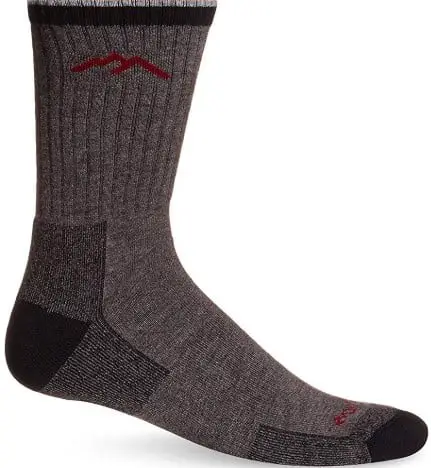
Any long-time hiker will tell you that not all socks can work for hiking. If you’re hiking, you’re looking for comfortable padding, seamless knitting, durable construction, and quick moisture-wicking.
The Darn Tough Coolmax Micro Crew Cushion Socks offers all of this in addition to being wool-free and being backed by a lifetime warranty.
It is made up of a blend of 37% Nylon, 34% Coolmax Polyester, 26% Acrylic, and 2% Lycra. Nylon adds durability and strength, despite being incredibly lightweight, so it is excellent for hiking socks. Also, it is extremely stretchable.
Coolmax Polyester is excellent for fast-action moisture wicking that prevents odor or bacteria, and rivals cotton in that field, which is a quality that every hiker desperately needs.
Acrylic has a wool-like feel without the cruelty behind wool. Additionally, it is mildew-resistant, so you don’t have to worry about any bacteria. Like Nylon, it makes the socks stretchy.
These socks fit so well, thanks to their ribbed support and high-density knit that prevent slipping, bunching, and blisters. Also, it has an undetectable toe seam. Furthermore, the mid-level cushion density around the toe and heel keeps you comfortable in long hikes.
We love the shorter micro-crew height because it makes the socks suitable for both shoes and boots, which is highly practical.
However, not all of Darn Tough’s socks are vegan, so make sure to always check the materials before you buy them.
2. Bamboo Dress Socks – Best Dress Socks
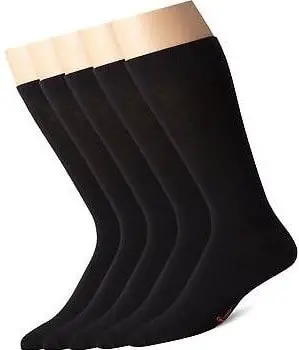
Regardless of your lifestyle, dress socks are a necessity because, at some point, you will have to dress in formal or smart outfits. Even if you don’t, the neutrality of colors in dress socks makes them good to wear in daily life too. The Bamboo Dress Socks are our favorite vegan ones.
The materials used in this bestseller are 80% Bamboo ,18% Polyamide ,2% Elastane.
Bamboo gives the socks their lightweightness combined with durability at an affordable price point.
Bamboo is comfortable, breathable, and hypoallergenic. In addition, it keeps your feet dry by absorbing moisture. The rest of the materials give the socks the needed elasticity to prevent them from sliding down like how some dress socks do.
They fit well and come in a variety of sizes so you can pick and choose. Despite their affordability, they look handsome and elegant. They come in a variety of dress colors as well.
3. Heat Holders Thermal Socks – Best Heated Socks
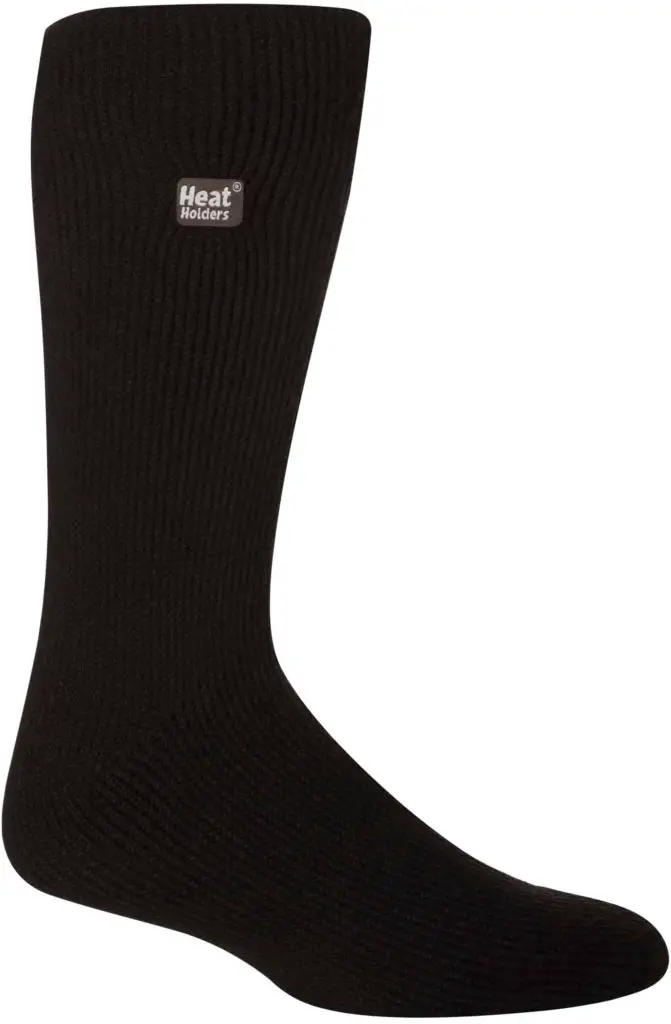
Some days are cold, but some other days can be really cold. No matter how heavy your clothes are, If your feet aren’t warm and comfortable on these freezing days, you’ll still feel cold.
With a TOG rating of 2.34 and an extra-long looped cushion pile, the Heat Holders Thermal Socks are 7 times warmer than basic cotton socks.
These socks are made from a specially developed heavy bulk yarn, and they consist of 91% Acrylic, 5% Nylon, 3% Polyester, and 1% Elastane.
The high percentage of Acrylic keeps your feet dry and warm. Also, Acrylic makes the socks highly elastic and form-fitting, which is what you expect from any good pair of heated socks. Acrylic is easy to clean, dry, and care for too. Furthermore, Acrylic is relatively inexpensive.
If you think vegan socks are limited in prints or colors, think again. The Heat Holders Thermal Socks come in a mindblowing selection of 27 different colors that cater to every taste.
4. Areke Men’s Performance Socks – Best Value

Having comfortable, soft, moisture-wicking, and durable socks shouldn’t cost an arm and a leg. The Areke Men’s Performance Socks give you all of this and more by being vegan. So, they won’t cost you much or cost a poor animal its life.
Our value choice is made from 88% Combed cotton, 9% Polyester, 2% Nylon, and 1% Spandex.
Combed cotton is even softer and has a higher quality than regular cotton because all of its impurities are removed. So, there is no chance of extra threads fraying. Also, it is more durable and stronger. Of course, its high percentage helps your feet breathe.
On the other hand, the Polyester in these socks makes them lightweight and wicks away their moisture to keep you comfortable and dry. Polyester is also inexpensive, despite its durability and resistance to shrinking or color fading.
These socks are cushioned underfoot to support your arch and help you hike and trek more. Moreover, the elastic closure prevents the socks from slipping down. Also, the toe seam is undetectable.
5. Dig Bamboo Fiber Socks – Most Eco-Friendly
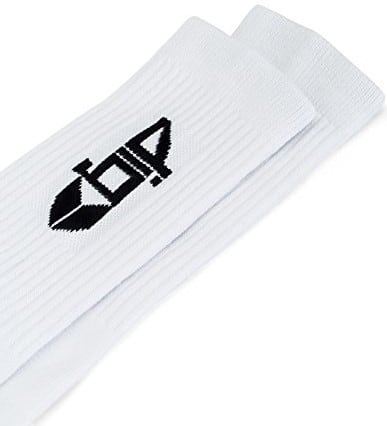
Sometimes when you try to be vegan, you make choices that aren’t sustainable or eco-friendly. Then, when you try to choose sustainable materials, they turn out not to be entirely vegan. Every person that is trying to make ethical choices in life knows this dilemma a bit too well.
The Dig Bamboo Fiber Socks are here to save you from this dilemma by being both vegan and eco-friendly. In addition, Dig Socks has the One Sock One Tree Program, where they plant a tree for every pair purchased. So far, they have planted 10287 trees.
So, what’s the big deal about bamboo? Bamboo is often compared to cotton. The thing is, it has cotton’s advantages without its disadvantages.
Like cotton, bamboo is breathable, absorbent, soft, hypoallergenic, and lightweight. It also helps keep you warm in cold weather and cool in hot weather.
Unlike cotton, it doesn’t need much water or land to grow. In fact, bamboo needs 1/3 less water than cotton. Furthermore, it doesn’t need pesticides or fertilizers. It is also one of the fastest-growing plants on earth, and it doesn’t even need replanting. So, it is definitely a more sustainable option.
Besides the high-quality bamboo, the Dig Bamboo Fiber Socks utilize their signature mesh toe vent for extra breathability. The elastic arch band is there to protect your feet. Moreover, the seamless toe closure prevents the possibility of any extra “threads”.
Finally, this pair comes in 7 different colors.
The Best Vegan Socks for Women in 2022
1. Physix Gear Sport Compression Socks – Best Compression Socks

Nothing beats the right pair of compression socks, and long flights will show you if you didn’t already know.
Compression socks improve lymphatic drainage and blood circulation. Also, they create better venous pressure and relieve leg pain, which is a highly beneficial feature for people with varicose veins.
In addition, they prevent swelling and increased fatigue resulting from working out, standing up, or sitting down all day.
The Physix Gear Sport Compression Socks benefit pregnant women, runners, travelers, nurses, patients with leg-swelling problems, and post-surgery patients. To do so, they’re made from an excellent blend of 70% Nylon and 30% Spandex.
This blend makes these socks durable and long-lasting because they’re made for all-day use. In addition, these materials make the socks elastic and resistant to shrinking and wrinkles. Moreover, their moisture-wicking abilities keep your feet dry all day.
Of course, their compression, which is focused on the heels, feet, calves, and toes areas, enhances your blood flow, which keeps you at optimum health.
Finally, they come in 12 fashionable color options because compression socks don’t have to look “medical” to be effective and practical.
2. Balega Hidden Comfort Socks – Best No-Show
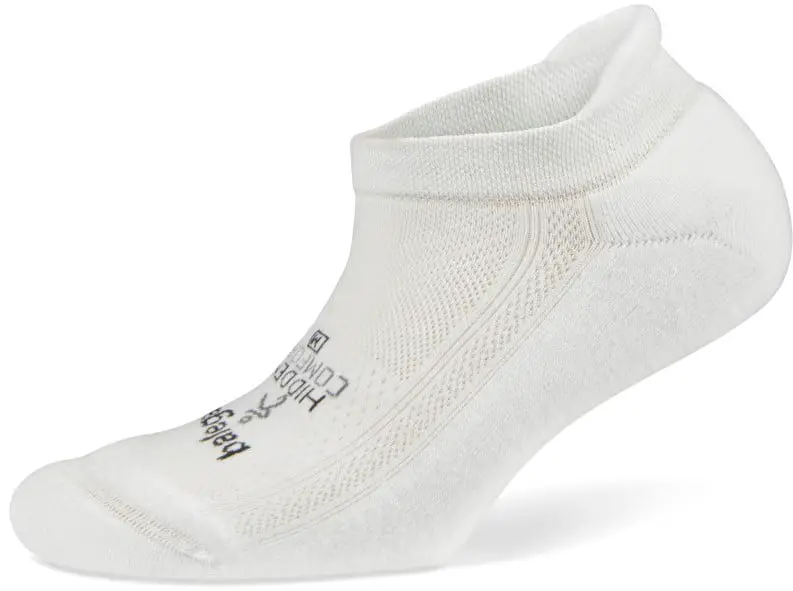
No-show socks are underrated and necessary. If you go sockless, the chances of sweat and odor rise. It is not only uncomfortable for you, but also for the poor people near you. The Balega Hidden Comfort Socks give athletes the sockless “look” while preventing them from reeking.
This pair is made of Drynamix, which is excellent for runners because it is true to its name by wicking moisture away from your feet and keeping them dry and sweat-free. In addition, these socks have specially constructed, reinforced microfiber mesh ventilation panels to let your feet breathe during your most active hours.
Furthermore, the enhanced Elastane ensures that the socks don’t fall down because nobody wants their socks slipping down while they’re running.
The toe seams are hand-linked to minimize friction and prevent chafing on top of the foot so your workout can be hassle-free. Furthermore, the toe and heel are reinforced to be as durable as needed for athletes.
Also, the Balega Hidden Comfort Socks have high-volume, impact-resistant cushioning and plush, 200-needle count fabric, which help provide you with race-tested foot protection, comfort, and reliability.
Another aspect that has to be mentioned is that these socks come in 16 different standout colors. Some may argue that color diversity doesn’t matter in no-show socks, while others appreciate the options anyway.
3. MD Premium Bamboo Socks – Best for Sensitive Skin
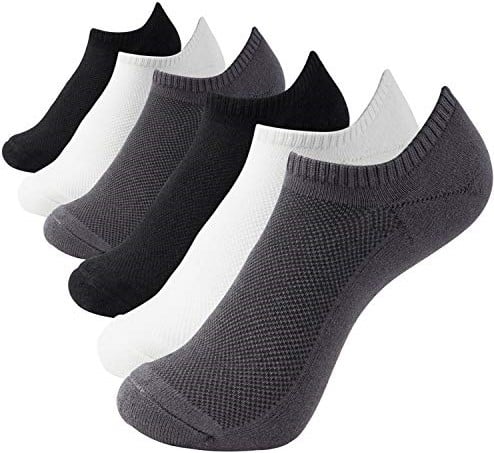
There is nothing more inconvenient than realizing you’re allergic to your socks after getting them. Socks are meant to provide you with comfort, even if you have sensitive or dry skin. So, the MD Premium Bamboo Socks are the answer to your prayers for a hypoallergenic pair.
They are made up of 81.1% Rayon from Bamboo, 16.5% Polyester, 1.4% Spandex, and 1% Elastic.
Bamboo is the most eco-friendly and easy-to-grow plant that you can make socks from. It is soft on the skin and breathable, thanks to its excellent air circulation. Its antimicrobial properties protect your feet from moisture, bacteria, and odor. Many believe that its moisture-wicking abilities surpass cotton.
So, bamboo socks can be used for casual, formal, or athletic use.
The Polyester in these socks makes them durable and easy to maintain, which is highly beneficial since it is inexpensive. Polyester also makes socks highly stretchable despite looking small. They don’t even lose elasticity or shape, no matter how many times you wash them.
We love that the MD Premium Bamboo Socks have extra cushioning along the bottom and toe area to reduce friction and irritation, which makes the socks gentle on sensitive skin. In addition, the big Y design on the heel makes the socks stay in place and not slip down no matter how active you are.
4. HASLRA Premium Soft Warm Microfiber Fuzzy Socks – For Warmth and Coziness
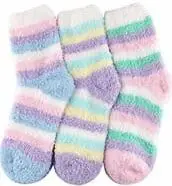
Some socks feel just like that: they’re socks that get the job done and nothing more. However, some socks feel like a hug to your feet.
The plushy HASLRA Premium Soft Warm Microfiber Fuzzy Socks keep you cozy and comfortable at home, and warm despite the winter if you’re outside. Also, they are still thin enough to be practical.
It is made from 93% Polyester, 5% Polyurethane, and 2% Span.
Like the Dockers Dress Socks, these socks definitely benefit from Polyester. It makes this pair warm, soft, and lightweight at the same time. Thanks to Polyester, you wash it by hand or machine. Moreover, it makes the socks affordable without compromising quality.
Finally, you’ll definitely fall in love with the vibrant colors that will make your winter and fall more lively than ever.
How to Pick Vegan Socks
100% Vegan Materials
This is pretty much obvious, but it had to be said.
You can either purchase your socks directly from strictly vegan manufacturers or inspect your socks of choice to make sure they don’t have animal-based materials such as wool, whose industry resulted in a lot of inhumane activities towards poor animals.
Vegan materials are either natural, as in plant-based, or synthetic, as in man-made.
Natural
The most popular plant-based material in socks is cotton, and it is for pretty good reasons.
Anyone struggling with sensitive skin will appreciate cotton’s hypoallergenic properties. Also, it is strong and abrasion-resistant, which means you don’t have to worry about machine-washing it. Furthermore, it is easy to dye, so it comes in a variety of colors.
Of course, we had to mention its heat insulation qualities. You won’t have to worry about wearing it when it is too hot because it will keep you cool with its breathability. It will keep you a bit warm in the winter as well. Finally, it absorbs body moisture to keep your feet dry.
On the other hand, cotton’s poor elasticity makes it shrink easily after every wash, so always go a size or two larger than your actual size. It also wrinkles a lot, so you may need to iron your socks from time to time.
If cotton isn’t your thing, consider bamboo. It is incredibly soft and comfortable to wear. In addition, it is antifungal, antibacterial, and odor-resistant, thanks to its moisture-wicking abilities that exceed cotton. Furthermore, it has the same awesome heat insulation abilities of cotton.
Like cotton, you don’t have to worry about your skin having an allergic reaction towards it. It is also the most eco-friendly option out there because we don’t have to use pesticides, fertilizers, or much water to grow it.
Its disadvantage is that it takes a lot of time to dry because of how well it absorbs moisture. Also, it is not as durable as cotton.
Synthetic
Synthetic socks are either made of different blended materials or of one synthetic fiber.
Socks can be made of blended materials of different proportions such as Acrylic, Nylon, Sherpa, Polyester, Lycra, cotton, Olefin, Rayon, and many more. On the other hand, other synthetic socks are made of one synthetic fiber, such as CoolMax, Drynamix, and Chenille.
The point of vegan synthetic materials is to replicate wool’s moisture-wicking and odor-controlling abilities without exploiting animals in the process. However, synthetic fibers tend to cause allergies to sensitive skin, so be careful.
Thickness
Some applications need thin socks, while others need thick. Knowing what activities these socks will be a part of will make your choices easier.
Daily chores won’t need anything more than inexpensive thin socks. However, you will need thick socks in the winter to warm your feet, especially if it gets really cold. Sports and outdoor activities need some padding in the heel and ball of the foot to make you feel comfortable. The more intense your activities are, the more durable the socks have to be.
Sock Fit
We don’t appreciate how our socks fit enough until we try on ones that neither look nor feel good. Socks should fit you just right. Having too much excess fabric causes folding, wrinkling, and friction. However, wearing socks that are too tight will cramp your feet and toes.
The way socks fit around your toes and heels tells you everything you need to know, so the best thing to do is try them on. Also, try them with the shoes they’ll be worn with; for example, try your hiking socks with hiking shoes to make sure they’re comfortable. If you can’t, pick your usual size.
Frequently Asked Questions
What Clothing Materials are Vegan?
Any clothing material that isn’t animal-based is vegan. So, even if some materials are used without directly killing animals, such as wool and horsehair, they are still non-vegan.
Natural vegan clothing materials are cotton, bamboo, hemp, jute, khaki, linen, cork, banana fabric, and plant-based leather. Synthetic vegan clothing materials include Acrylic, Nylon, Polyester, Spandex, Olefin, Microfiber, and faux fur.
Are Wool Socks Vegan?
Despite popular belief, wool couldn’t be farther from veganism. Because wool is basically the hair of many animals such as sheep, goats, and camels, taking it doesn’t kill these poor creatures.
However, the process of shearing isn’t as humane as you think because it is all about how much profit can be made off of each animal. Also, thousands of animals die from heat stress due to growing excess wool resulting from being bred to be shorn.
Are Bamboo Socks Eco-friendly?
Besides being cruelty-free and vegan, bamboo socks are the most sustainable and eco-friendly among all socks.
Bamboo grows pretty fast and needs very little water, especially when compared to cotton. In addition, it doesn’t need fertilizers or pesticides. Also, it needs less land to grow on. Furthermore, bamboo prevents soil erosion and improves air quality.
Final Thoughts
Veganism, fashion, and practicality can go hand in hand. By choosing to get vegan socks, you’re protecting our wooly friends without compromising your personal needs. So, here is a summary of the best vegan socks.
Athletes need tough socks that are also comfortable, which is why we recommend the Darn Tough Coolmax Micro Crew Cushion Socks and the Physix Gear Sport Compression Socks.
If you’re looking for maximum softness and coziness, consider the Areke Men’s Performance Socks and the HASLRA Premium Soft Warm Microfiber Fuzzy Socks.
People with sensitive or dry skin that gets irritated easily will appreciate the MD Premium Bamboo Socks.


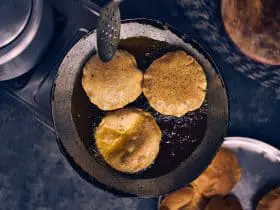



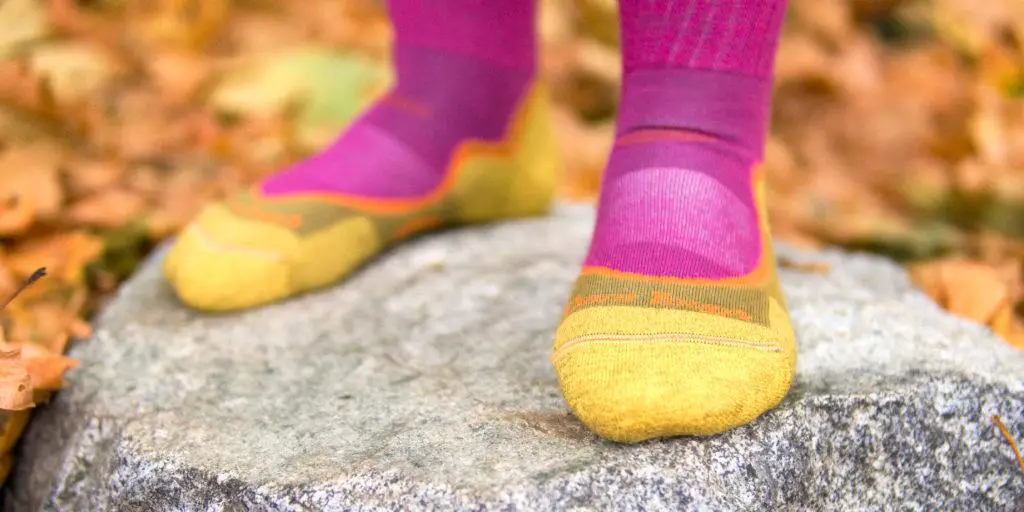
![The 15 Best Vegan Clogs in 2023 [for Women + Unisex] 27 best vegan clogs](https://getvegan.com/wp-content/uploads/2020/08/vegan-clogs-280x210.jpg)

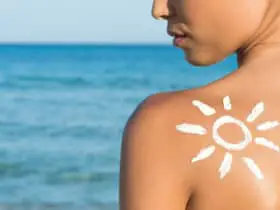
![[Company Profile] Will's Vegan Shoes: The Best Products They Offer 47 Will's Vegan Shoes](https://getvegan.com/wp-content/uploads/2021/10/wills-vegan-shoes-280x210.jpg)

Leave a Reply